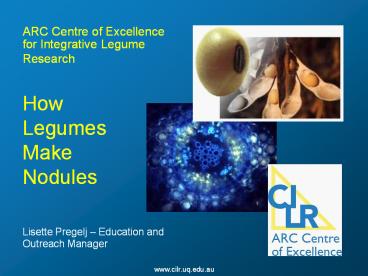ARC Centre of Excellence PowerPoint PPT Presentation
1 / 29
Title: ARC Centre of Excellence
1
ARC Centre of Excellence for Integrative Legume
Research How Legumes Make Nodules Lisette
Pregelj Education and Outreach Manager
2
Legume Nodules
- Legume nodules are special plant organs that
house nitrogen-fixing bacteria called Rhizobium - Nodules form on Legume roots
- Nodules can also form on stems in some species
3
(No Transcript)
4
Vascular Bundles
Nodule Cortex
Sclerenchyma
Rhizobium Filled Cells gt25,000 per cell
Nodule Cross-Section
5
Nodule Formation
- 1. Rhizobia attracted to root
- 2. Rhizobia attach to root hairs
- 3. Root hair curling
- 4. Infection thread formation
6
Nodule Formation
- 5. Root cortical cell division
- 6. Rhizobia invade cortical cells
- 7. The nodule grows
- 8. Fully functional nodule
7
1 Rhizobia attracted to root
8
1. Rhizobia attracted to root
- Legume roots exude flavonoids
- (Soybean exudes the isoflavone genistein)
- Rhizobia are attracted to flavonoids
Bacteria turn blue when a reporter gene is
switched on by plant exudates (flavonoids)
Petri dish contains a bacterial lawn
9
2. Rhizobia attach to root hairs
Rhizobia
Root Hair
10 mm
10
2. Rhizobia attach to root hairs
Deformed root hairs
Curled root hair
Vascular bundle
11
3. Root hair curling
50 mm
12
4. Rhizobia infect root hair
Root Hair Curling
Infection Thread
Root Hair
Rhizobia
Infection Pocket
Legume Root
Vascular Bundle
13
4. Rhizobia infect root hair
50 mm
14
5. Root cortical cells divide
100 mm
15
5. Root cortical cells divide
100 mm
16
6. Rhizobia invade cortical cells
50 mm
17
7. The nodule grows
2-4 mm
18
8. Fully functional nodule
root
nodule
Rhizobia (green marker)
100 mm
19
Nodulation Timeline
Roots
1-2 days post inoculation (dpi)
Inoculation (day 0)
4 dpi
4-6 dpi
10 dpi
3 weeks pi
20
Chemical Signals
- Nodulation involved chemical signals
- Released by both the Legume plant and the
Rhizobium bacteria
Flavones
Nod Factors
21
(No Transcript)
22
Flavones and Isoflavones
- Released by Legume roots
- Signal Rhizobia in the soil that a Legume is
present and ready to nodulate - Soybean releases Genistein, an isoflavone
23
Flavones and Isoflavones
Flavonoids in Root tip and Thickened root
24
Nod Factors
- Rhizobia in response to flavones release Nod
factors - Nod factors are sugars with specific signalling
functions - Nod factors signal to a legume that Rhizobia are
present in the soil and ready to live in nodules
25
Nod Factors
- Each Rhizobum species releases unique Nod factors
- All Nod factors have a concerved backbone
- Difference is in the decorations (R1 R2 R3 R4 R5)
and number (n) of sugar repeats
26
Nod Factor Receptors
- Each legume species has receptors specific to a
unique Nod factor - Therefore each legume species nodulates with its
own Rhizobium - Soybean -Bradyrhizobium japonicum
- Lotus Mesorhizobium loti
- General Rhizobium NGR234
27
CILR
- University of Queensland
- Australian National University
- University of Melbourne
- University of Newcastle
28
CILR
- ARC Centre of Excellence for Integrative Legume
Research - Contact Us
- HQ University of Queensland
- Tel 3365 3550
- Email director.CILR_at_uq.edu.au
- lisette.pregelj_at_uq.edu.au
- Visit Our Website!
- www.cilr.uq.edu.au
29
Picture and Diagram Credits
- Uli Mathesius
- Mark Kinkema
- Peter Gresshoff
- Dana Hoffmann
- Michael Sheahan
- Sureeporn (Ning) Nontachaiyapoom
- Paul Scott
- Brett Ferguson

